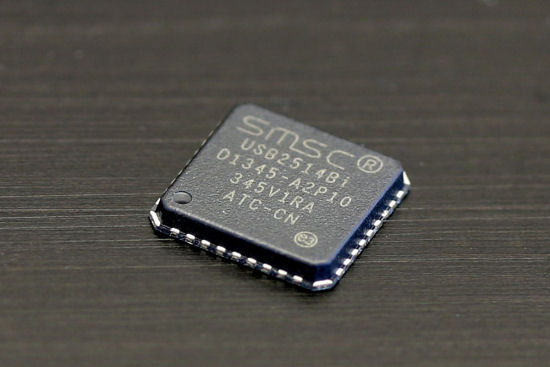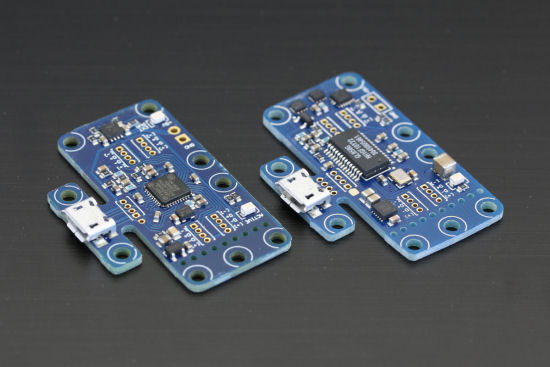![]() This week, we announce the Micro-USB-Hub-V2. It's a new USB 2.0 hub. It is fully compatible with the first version, it is better, and it even costs a little bit less :-)
This week, we announce the Micro-USB-Hub-V2. It's a new USB 2.0 hub. It is fully compatible with the first version, it is better, and it even costs a little bit less :-)

The new Micro-USB-Hub-v2
Why a new version?
The first Micro-USB-Hub was based on a GL850G chip by Genesis, a Chinese company. Originally, we selected this component because it was the most commonly used: if you buy three cheap USB hubs at the nearest store, most likely at least two of them are based on one or several GL850G.

The Genesis GL850G, inside almost all available hubs
However, we had some issues with the GL850G. We couldn't find a European distributor who agreed to sell small quantities of the chip at a reasonable price. So we had to resign ourselves to buy the chips directly from China, from a different distributor each time, each time fearing to buy forgeries. Therefore we decided to base our new model on a USB2514Bi chip by SMSC/Microchip, much easier to find in Europe.

The USB2514Bi by SMSC/Microchip
The other reason motivating the new Micro-USB-Hub-V2 hub is the external power source of the Micro-USB-Hub. We noticed that when a shut off external power source was connected to the hub while the hub was connected to a computer, the power source could behave like a consumer, drawing current through the diodes protecting the chip. This could even cause the destruction of the hub. Fortunately, this seems to happen only in very rare circumstances. Therefore, we completely redesigned the external power source part to prevent this problem to occur ever again.
Compatibility
From a mechanical stand point, the new Micro-USB-Hub-V2 is fully compatible with the old Micro-USB-Hub: same dimensions, same shape, same fixation holes, same connectors at the same locations and in the same direction.

The two hubs are mechanically compatible
We slightly modified the meaning of the led. Instead of indicating whether the hub was powered, it now gives evidence of the hub activity: it lights up if at least one device is connected to the hub. If no device is detected, the led stays off and the hub continues sleeping. There is also an additional led indicating whether the hub works on the external power source rather than on the USB bus.
Multi-TT
From the USB stand point, the main difference is the number of translators. In short, in a USB 2.0 hub, the translators must translate the data coming from the USB 1.1 down ports to the USB 2.0 standard before sending them on the up port. Most USB 2.0 hubs have only one translator for all the ports. This sometimes causes congestion issues when there are many "talkative" USB 1.1 devices connected at the same time.
While the GL850G of the Micro-USB-Hub has one and only one translator (single-TT), the USB2514Bi of the Micro-USB-Hub-V2 has 4 of them (multi-TT), one for each port. That's good, all the Yoctopuce modules are USB 1.1 devices :-)
Conclusion
The new Micro-USB-Hub-V2 replaces therefore advantageously the old Micro-USB-Hub, both feature-wise and money-wise: as it costs us a bit less to produce it, it costs you a bit less to buy it :-)


